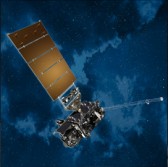 Lockheed Martin has handed to the National Oceanic and Atmospheric Administration the second Geostationary Lightning Mapper for integration with NOAA’s second Geostationary Operational Environmental Satellite.
Lockheed Martin has handed to the National Oceanic and Atmospheric Administration the second Geostationary Lightning Mapper for integration with NOAA’s second Geostationary Operational Environmental Satellite.
The GLM sensor will fly onboard the GOES-S spacecraft and will work to monitor lightning from geostationary orbit in order to detect and provide warnings on tornadoes, storms and other severe weather conditions across the U.S. and Western Hemisphere, Lockheed said Tuesday.
“We reduced the build and test time of this complex instrument by 40 percent compared to the first unit,” said Jeff Vanden Beukel, GLM program director at Lockheed.
Lockheed built the GLM instrument at its facility in Palo Alto, California and plans to perform integration work at its facility in Denver.
NASA’s Goddard Space Flight Center oversees the development of the GLM tool, while NOAA runs the GOES program.




